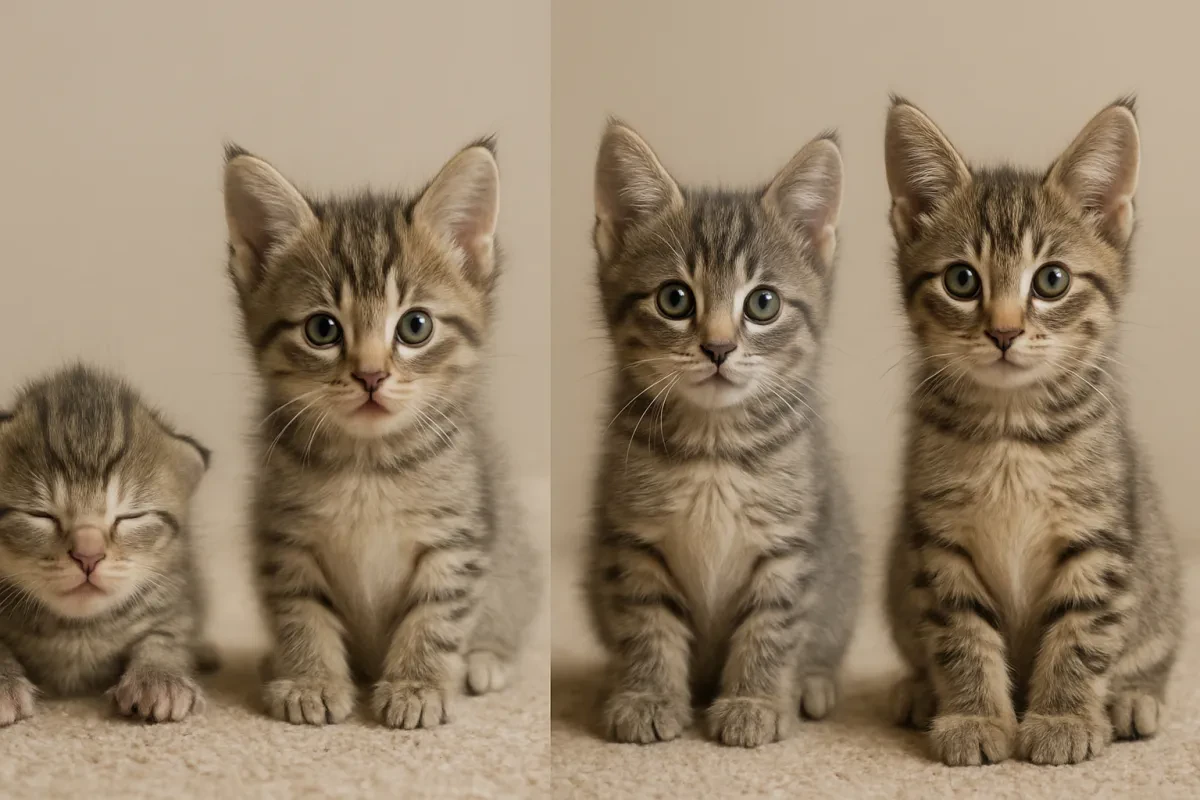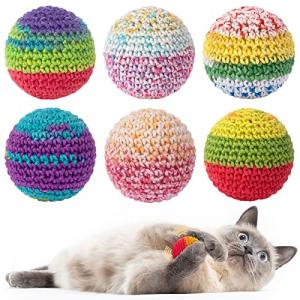🐾 Kitten Development: What to Expect Month by Month
A playful, science-backed, and slightly cheeky guide to raising your pint-sized panther
From Paws to Pro Pouncer — Watch the Magic Unfold
Picture this: a creature so tiny it fits in your palm, eyes closed, mewing softly like a squeaky toy. Fast forward a few months, and that same bundle of fluff is scaling curtains, ambushing your toes, and declaring itself ruler of your home. Welcome to the whirlwind of kittenhood — a rapid-fire transformation of growth, curiosity, and chaos (the adorable kind).
Kittens grow faster than you can say “furball.” One moment, they’re nursing; the next, they’re chasing invisible enemies at 3 a.m. This month-by-month guide breaks down every stage — the milestones, the mischief, the care, and the cuddles — so you can understand exactly what’s happening inside that little ball of wonder.
Let’s hit “play” on the cutest growth timeline in nature.
Month 0 (Weeks 0–4): The Fragile Beginnings
What’s Happening
At birth, kittens are tiny miracles — but also totally helpless. Their eyes and ears are closed, they can’t walk, and they can’t regulate their body temperature. Everything — warmth, food, even bathroom breaks — depends on their mother (or a very devoted human caregiver).
By around one week, those little noses start twitching more actively, and faint squeaks turn into determined mews. Between 7–10 days, eyelids begin to part, revealing blue, blurry eyes that won’t focus clearly for another week or two. Ears pop open shortly after, and suddenly, the world gets louder — which explains why newborn kittens often look adorably startled by their own surroundings.
Milestones
-
Eyes open (around days 6–12)
-
Ears unfold and hearing develops
-
Wobbly crawling begins
-
Tiny teeth start to peek through around week 3
Care Tips
-
Keep kittens warm at all times (around 85–90°F for newborns)
-
If bottle-feeding, use kitten formula every 2–3 hours (never cow’s milk!)
-
Stimulate elimination with a soft cloth or cotton ball
-
Weigh daily — steady weight gain is the best sign of health
By the end of this phase, your kittens will start toddling around, sniffing everything, and attempting mini pounces that look like slow-motion tumbles. The fun is just beginning.
Month 1 (Weeks 4–8): Weaning, Wobbling, and Wonder
What’s Happening
Week 4 marks a significant leap: teeth emerge, balance improves, and curiosity skyrockets. The formerly helpless fluffballs now toddle around, experimenting with walking, wrestling, and occasionally faceplanting.
Around this time, they’ll start showing interest in their mom’s food — or your plate if they’re hand-raised. Introduce soft, mushy kitten food mixed with formula (“kitten gruel”) and gradually transition to solid meals by week 7–8.
Their play becomes purposeful — chasing tails, stalking siblings, and practicing pounces. These aren’t just cute antics; they’re essential lessons in coordination, hunting, and social interaction.
Milestones
-
Walking and running begin
-
The complete set of baby teeth appears by week 7–8
-
Eye color begins to shift from baby blue to the adult hue
-
Early litter box training and self-grooming start
-
The socialization window opens wide — exposure to humans, sounds, and new environments shapes their lifelong personality.
Care Tips
-
Offer kitten-safe wet food and clean water at all times
-
Use shallow, non-clumping litter for first-timers
-
Schedule the first vet checkup and vaccinations
-
Encourage gentle handling and interactive play
By eight weeks, most kittens are eating solid food, exploring confidently, and learning the fine art of being charmingly destructive.
Month 2 (Weeks 8–12): The Curious Explorer
What’s Happening
Now the world is their playground. Coordination improves dramatically — leaps are more precise, chases are faster, and that tiny fluffball suddenly moves with surprising grace.
Kittens at this stage are like toddlers on espresso. They’ll sprint, climb, and explore every nook, with an energy level that seems to defy physics. They’re also learning about hierarchy — with littermates, older cats, and you. Expect a bit of attitude as they figure out who’s boss (spoiler: it’s probably them).
Milestones
-
Fully weaned and litter trained
-
High energy and endless curiosity
-
Grooming and independence increase
-
Begin developing social hierarchies and testing boundaries
Care Tips
-
Schedule the second round of vaccinations
-
Begin nail trims and brushing routines early
-
Introduce scratching posts, climbing trees, and puzzle toys
-
Continue socialization: expose them to new people, textures, and gentle noises
At this stage, kittens are soaking up experiences like sponges. Every cuddle, sound, and scent shapes the cat they’ll become — confident or cautious, cuddly or independent.
Month 3 (Weeks 13–16): The Playful Prodigy
What’s Happening
The three-month mark is prime “kitten chaos.” Muscles are defined, balance is sharp, and curiosity is off the charts. Your kitten is now a master explorer and a professional mischief-maker. They’ll test every boundary — from leaping onto countertops to unraveling your toilet paper.
Teething is in full swing as adult teeth push through. You may notice extra chewing, drooling, or mild grumpiness. Provide safe toys for gnawing to ease discomfort (and save your furniture).
Milestones
-
Teething begins — adult teeth start to emerge
-
Coordination and agility peak
-
Energy surges during “zoomie” sessions
-
Increasing independence, but still deeply social
Care Tips
-
Provide safe chew toys for teething
-
Reinforce training and play boundaries
-
Keep vaccinations and parasite prevention up to date
-
Begin discussing spay/neuter timing with your vet
This is also when personality really blooms — from fearless adventurer to shy snuggler, you’ll start seeing the cat your kitten is destined to become.
Set of 6 Retro Wool Cat Balls with Bell
Add a playful touch to your cat's toy collection with these charming wool balls that jingle with every pounce
Product information
$13.98
Product Review Score
4.58 out of 5 stars
86 reviewsProduct links
Month 4: The Teenager Emerges
What’s Happening
Congratulations — your kitten just hit “tween” mode. They’re more confident, more mischievous, and more likely to test limits. You might notice new behaviors, such as scratching furniture or asserting dominance over other pets.
Physical growth is still rapid. By month 4, many kittens reach around 60–70% of their adult size, but with a lanky, awkward look — like feline teenagers in growth spurts.
Milestones
-
Sexual maturity begins for some kittens
-
Marking or spraying may appear in unneutered males
-
Increased confidence and assertiveness
-
Continued refinement of balance and jumping skills
Care Tips
-
Begin discussions about spaying or neutering
-
Provide vertical climbing options to burn energy
-
Redirect destructive scratching with multiple scratching posts
-
Keep mealtime consistent — three small meals daily are ideal
This is a crucial month for training. Set boundaries with positive reinforcement, and you’ll prevent many unwanted habits down the line.
Months 5–6: The Adolescent Phase
What’s Happening
Ah, kitten adolescence — the “rebellious teenager” stage. They’re stronger, smarter, and occasionally too clever for their own good. Expect bold behavior, more vocalization, and a healthy dose of attitude.
Hormones are kicking in. If your kitten isn’t fixed yet, you might see behaviors like spraying, yowling, or attempts to escape outdoors in search of a mate. Neutering or spaying around this time can help curb these tendencies and prevent health and behavioral issues later.
Milestones
-
Growth rate begins to slow
-
Adult teeth fully replace baby teeth
-
Heightened curiosity and territorial exploration
-
Developing hunting instincts and play aggression
Care Tips
-
Reinforce litter box routines and positive behavior
-
Provide plenty of play and mental stimulation
-
Stick to a consistent schedule to reduce stress
-
Discuss dietary changes as energy needs evolve
Don’t worry — the chaos of adolescence won’t last forever. These months are a test of patience, but also among the funniest and most entertaining times of kittenhood.
Months 7–9: Maturing Minds and Muscles
What’s Happening
Your kitten is growing into their adult body — more streamlined, muscular, and graceful. Energy levels even out, though zoomies still strike unexpectedly (especially at 2 a.m., of course).
Social and territorial instincts are sharpening. You’ll notice more transparent communication through body language — tail flicks, slow blinks, and “chirps” of conversation. If you have multiple cats, you’ll also see the formation of hierarchies and routines.
Milestones
-
Sexual maturity is fully established
-
Increased coordination and confidence
-
Behavioral patterns and routines form
-
Energy levels balance between play and rest
Care Tips
-
Ensure they’re fully transitioned to adult food if approved by your vet
-
Keep up regular vet checks and parasite control
-
Offer enrichment toys that challenge their mind — treat puzzles, scent games, or training sessions.
-
Watch for weight changes — growth slows so that portion sizes may need adjustment.
Your once-tiny kitten is becoming a graceful young adult. But make no mistake — they still have plenty of kitten energy (and mischief) left in the tank.
Months 10–12: Almost a Cat!
What’s Happening
By their first birthday, your kitten is essentially an adult — though emotionally, they might still act like a goofy teenager. Their coordination is sharp, their hunting skills are honed, and they move with the confidence of a fully grown feline.
Most cats reach full size by 12 months (large breeds like Maine Coons can take up to 18 months). By now, play is more measured but still enthusiastic. You’ll notice longer naps, quieter curiosity, and more profound attachment to their routines and favorite humans.
Milestones
-
Full adult coat and body shape
-
Stable personality and routine
-
Less frantic energy, more calculated play
-
Strong emotional bond with humans
Care Tips
-
Transition to adult food (usually around 12 months)
-
Schedule annual vet checkups for vaccines and dental care
-
Maintain an engaging environment — scratching posts, perches, windowsills, and toys
-
Celebrate the milestone! You survived kittenhood, and your cat thrived
By the time your cat turns one, you’ll look back at baby photos and barely believe that little puffball turned into this confident, majestic creature sharing your couch.
Quick Reference: Kitten Milestone Summary
| Month | Key Milestones | Behavior Snapshot | Care Focus |
|---|---|---|---|
| 0 (0–4 wks) | Eyes/ears open, crawling begins | Fragile, dependent | Warmth, feeding, weighing |
| 1 | Teeth, walking, first play | Curious, socializing | Weaning, vet visit |
| 2 | Full play coordination | Energetic explorer | Vaccines, grooming intro |
| 3 | Teething, independence | Confident, mischievous | Training, safe play |
| 4 | Puberty signs | Testing limits | Reinforce boundaries |
| 5–6 | Adolescence | Rebellious, vocal | Spay/neuter, enrichment |
| 7–9 | Near adulthood | Calmer confidence | Nutrition, mental play |
| 10–12 | Full adult form | Mature, bonded | Routine care, celebration |
Common Kitten Parent Questions
When should I spay or neuter my kitten?
Most vets recommend between 4 and 6 months, before hormonal behaviors set in.
Why is my kitten suddenly moody or skittish?
Hormonal changes and new experiences can trigger mood swings — consistency and patience help them adjust.
My kitten bites and scratches during play. Is that normal?
Totally normal, but not ideal. Redirect with toys, never hands or feet, so they learn appropriate play boundaries.
When do kittens stop growing?
Most finish physical growth by 12 months, but large breeds may take up to 18 months to fully mature.
How can I support healthy growth?
Feed high-quality kitten food, ensure regular vet care, provide enrichment, and socialize them early.
The Joy (and Chaos) of Raising a Kitten
Raising a kitten isn’t just about feeding and playing — it’s about watching nature’s magic unfold in fast-forward. You’ll witness transformation, triumphs, and a few tattered curtains along the way. Every month brings new surprises: the first confident leap, the first gentle purr, the first “look what I knocked over” moment.
Your role is part guardian, part teacher, and part audience to the best comedy show ever staged. With patience, love, and a sprinkle of humor, you’ll guide your little predator-in-training into a healthy, happy, confident cat — and gain a lifelong companion in the process.
So buckle up and enjoy the ride — kittenhood is wild, wonderful, and way too short.




